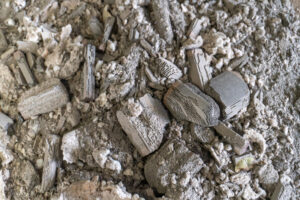Rhodium is a rare metal that does not rust.
Rhodium is a rare, shiny silver-white transition metal known for its exceptional corrosion resistance. It belongs to the platinum group elements (ruthenium, rhodium, palladium, osmium, iridium and platinum). It was discovered in 1803 by British chemist William Hyde Wollaston, who named it after the Greek word ‘rhodon’ (rose) due to the pink crystals observed during its isolation.
Rhodium is one of the hardest and rarest elements on Earth. It is durable, has high reflectivity and catalytic activity. These properties contribute to its popularity in various industrial applications. In addition to its use in alloys in catalytic converters, rhodium also finds application in a wide range of technologies .
The automotive industry uses rhodium in three-way catalytic converters. Here, it converts harmful nitrogen oxides into less harmful substances: nitrogen (N₂) and carbon dioxide (CO₂). In addition to rhodium, three-way catalytic converters often contain platinum and palladium. These are responsible for converting hydrocarbons and carbon monoxide (CO) into water and carbon dioxide (CO2) .
The chemical industry uses rhodium catalysts to produce certain basic chemicals. One example is the Ostwald process for producing nitric acid.

Rhodium is also very popular in the jewellery industry. It is extremely resistant to corrosion and oxidation, even at high temperatures. That is why it is used to refine jewellery, such as white gold or silver. This process is called ‘rhodium plating’. It ensures a bright, shiny and abrasion-resistant surface that keeps the jewellery beautiful for longer. Rhodium is very skin-friendly in jewellery (e.g. in nickel-free jewellery).
Additionally, it is utilized in the electronics industry to coat electrical contacts, preventing corrosion and enhancing conductivity. Researchers also use thin layers of rhodium for highly reflective mirrors in devices such as X-ray imaging equipment.
Rhodium is also used in nuclear reactor detectors to measure local power or neutron flux within specific reactor areas.
Rhodium also plays a specialized role in the hydrogen economy. In certain electrolysis processes, such as PEM electrolysis, it is used as a coating or alloy component to improve the efficiency of hydrogen evolution (HER – hydrogen evolution reaction). In fuel cells, rhodium alloys help prevent catalyst poisoning by carbon monoxide, extending the catalyst’s service life . Due to its high cost and limited supply, rhodium is reserved for demanding, high-performance applications.
Rhodium has no known biological function and may be harmful to health in some forms.

Rhodium is among the rarest metals on earth, with an average concentration of 0.0002 ppm. It occurs in pure form as a separate mineral and is often found alongside platinum group elements or gold.
Extracting rhodium is complex because platinum group elements are chemically similar and unreactive, making separation both difficult and costly.
As a result, recycling rhodium is increasingly important. Most recovered rhodium comes from used catalytic converters, electronic waste, and jewelry. Major producers include South Africa, Russia, and Zimbabwe, which introduces geopolitical risks .
In March 2024, platinum group elements were listed as the 27th critical material on the list of 34 strategic raw materials (SRM) under the European Critical Raw Materials Act.
Further information: